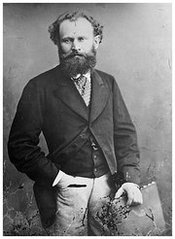|
|

Édouard Manet (January 23, 1832 – April 30, 1883) was a French painter. One of the first 19th century artists to approach modern-life subjects, his art bridged the gap between realism and impressionism.
Édouard Manet was born in Paris, France. His mother, Eugénie-Desirée Fournier, was the goddaughter of the Swedish crown prince, Charles Bernadotte from whom the current Swedish monarchs are descended, and his father, Auguste Manet, was a French judge. His father wanted him to also pursue a career in law, but he wanted a career in the arts. His uncle, Charles Fournier, encouraged him to pursue painting and often took young Manet at the Louvre.
From 1850 to 1856, after failing the examination to join the navy, Manet studied under academic painter Thomas Couture. In his spare time he copied the old masters in the Louvre. He visited Germany, Italy and the Netherlands, during which time he absorbed the influences of the Dutch painter Frans Hals, and the Spanish artists Diego Velázquez and Francisco José de Goya.
Manet, in imitation of the then current style of realism initiated by Gustave Courbet, painted everyday subjects like beggars, cafés, bullfights, and other events and scenery. He produced very few religious, mythological, or historical paintings.
Manet.dejeuner.750pix.jpg
One of Manet's best known early paintings is The Luncheon on the Grass (Le déjeuner sur l'herbe). The Paris Salon rejected it for exhibition in 1863 but he exhibited it at the Salon des Refusés (Salon of the rejected) later in the year. (Emperor Napoleon III initiated The Salon des Refusés, after the Paris Salon rejected more than 4,000 paintings in 1863.) The painting's juxtaposition of dressed men and a nude women was controversial, as was its abbreviated sketch-like style — an innovation that distinguished Manet from Courbet. However, Manet's composition is derived from Marcantonio Raimondi's engraving The Judgment of Paris (c. 1510) after a drawing by Raphael. Manet took respected works by Renaissance artists and updated them, a practice he also adopted in Olympia (1863), a nude portrayed in a style reminiscent of the early studio photographs, but which was based on Titian's Venus of Urbino (1538).
The roughly painted style and photographic lighting in these works was seen as specifically modern, and as a challenge to the Renaissance works Manet updated. His work is considered early modern because of its black outlining of figures that draws attention to the surface of the picture plane and the materiality of paint.
He became friends with the impressionists Edgar Degas, Claude Monet, Pierre-Auguste Renoir, Alfred Sisley, Paul Cézanne, and Camille Pissarro in part through his sister-in-law Berthe Morisot, who was a member of the group.
Unlike the core impressionist group, Manet consistently believed that modern artists should seek to exhibit at the Paris Salon rather than abandon it. Though his own work influenced and anticipated the impressionist style, he resisted involvement in impressionist exhibitions, partly because he did not wish to be seen as the representative of a group identity, and partly because of his disapproval of their opposition to the salon system. Nevertheless, when Manet was excluded from the International exhibition of 1867, he set up his own exhibition.
Manet,_Edouard_-_Self_Portrait_with_a_Palette.jpg
He was influenced by the impressionists, especially by Monet, and to an extent Morisot. Their impact is seen in Manet's use of lighter colors, but he retained his distinctive use of blocks of black, uncharacteristic of impressionist painting. He painted many outdoor (plein air) pieces, but always returned to what he considered serious work in the studio.
Throughout his life, though resisted by art critics, Manet had many champions. Émile Zola supported him publicly in the press, and Stéphane Mallarmé, as well as Charles Baudelaire, who had challenged him to depict life as it was. Manet, in turn, made many sketchings of them.
In 1875 a French edition of Edgar Allan Poe's The Raven included lithographs by the Manet and translation by Mallarmé.[1] (http://digitalgallery.nypl.org/nypldigital/dgkeysearchresult.cfm?parent_id=173889&word=)
Edouard_Manet._A_Bar_at_the_Folies-Bergère.JPG
In 1881, with pressure from his friend Antonin Proust, the French government awarded Manet the Legion of Honor.
He painted his last major work, A Bar at the Folies-Bergère (Le Bar aux Folies-Bergère), in 1881–1882 and it hung in the Salon that year.
Manet died of untreated syphilis, which caused much pain and partial paralysis from locomotor ataxia in his later years. His left foot was amputated because of gangrene 11 days before he died.
He died in Paris in 1883 and is buried in the Cimetière de Passy, Paris, France.
In 2000, one of his paintings sold for over $20 million.
External links
- The Impressionsts: Manet at biography.com (http://www.biography.com/impressionists/artists_manet.html)
- Édouard Manet at Olga's Gallery (http://www.abcgallery.com/M/manet/manet.html)de:Édouard Manet
es:Édouard Manet fr:Édouard Manet fy:Edouard Manet it:Edouard Manet nl:Edouard Manet ja:エドゥアール・マネ pl:Édouard Manet ru:Эдуар Мане sv:Édouard Manet uk:Мане Едуард zh:愛德華·馬內 he:אדוארד מאנה

